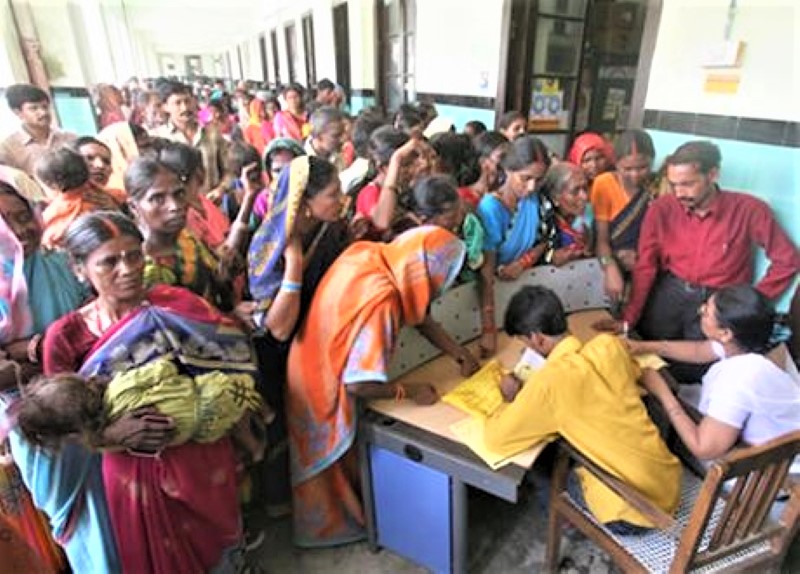In the waiting room of a private hospital of Darbhanga, few of the attendants had chit chat, and the conversation ended up on Ayushman Bharat scheme. The women around were keen to know the process to avail the card and try to spell out the Ayushman Bharat. When an old man found one of the women in difficulties to pronounce Ayushman Bharat, he said ‘aree Ayushsman Bharat bolne nahi aata hai to Usmaan Bharat bol do’ (if you can’t pronounce Ayushman Bharat call it Usmaan Bharat).
This conversation is to understand how different people perceive programs differently, positioned in the varied social and political structure, and also as a metaphor to understand the program. One at the centre, the Indian policymakers named it as Ayushman Bharat while at margin people call it Usman Bharat or might be some other word depends on identities of the person. Usman is an Arabic word; literary meaning is chosen one that can be interpreted as target group of the scheme, whereas Ayushman, a Sanskrit word means long-lived similar to the goal or dream of the program. Whether this scheme is just a dream of the policymakers (Ayushman) or is it for the target group (Usman)? It’s an attempt to understand the reality of the program through budgetary allocation of the year 2019-2020 and anecdotal evidence, keeping these questions in the loop.
On 1st February 2018, the Union Minister for Finance and Corporate Affairs Late Mr. Arun Jately announced the world’s most extensive government-funded health care program and named it as Ayushman Bharat. He mentioned the Health and Wellness Centre and National Health Protection Scheme as two initiatives under Aysuhman Bharat for building New India 2022 and ensuring enhanced productivity, well being, avert wage loss and impoverishment (PIB, 2018)[i]. The second initiative is known as Pradhan Mantri Jan Arogya Yojana (PM-JAY); has provision to cater ten crore poor and vulnerable families for coverage of 5 lakh rupees per year per family in secondary and tertiary hospitals.
On 23rd September 2018, the prime minister officially launched the program at Ranchi. It’s been a year for executing this program in the country. Until now, most of the states except Delhi, Odisha, West Bengal, and Telangana have run the program. The state where the program has been executed, 10.3 crore cards have generated, 18236 hospitals empanelled and around 46.5 lakh people have benefitted as per the government data (Annual Report 2018-2019: Ayushman Bharat, 2019)[ii]. Although the holistic analysis of the program is required for evaluation, however, the critical controversies of fraud in the private hospitals are surfacing through different news reports, and commentaries are censorious concerning its implementation. Besides this, fieldwork experiences after the suspected Acute Encephalitis Syndrome outbreak in Muzaffarpur and neighbouring districts supported by Gandhian organizations have other aspects to reflect upon this scheme.[iii]
Baiju Sahni (name changed) is agricultural labour resides in Harbanspur village of Vaishali district, Bihar. He has two daughters and lost two sons in the suspected Acute Encephalitis Syndrome outbreak in the state. On 7th June, at around 4 am his son suddenly started convulsion and fever. First he admitted his son in the private clinic at Lalganj, but they referred his son to SKMCH, Muzaffarpur (government hospital)[iv] but he didn’t take him to the government hospital directly as he doesn’t trust the public institution. He preferred to go for a private hospital in Muzaffarpur; however, this hospital again referred the patient to SKMCH, Muzaffarpur, where his son died on 8th of June. His second son also took his last breath in the same hospital on the same day.
Whatever expenditure (small amount) private hospital noted for the treatment; he wanted to exempt it through Ayushman Bharat card however the hospital administration denied by saying such small amount would not be considered in the Ayushman Bharat. Baiju Sahani has not only received such a response. Most of the families we interviewed who have visited private hospitals have narrated a similar story. According to different narratives, private hospitals do not consider Ayushman card until the expenses will not cross 60-70 thousand and the small amount is expected from the poor’s pocket.
Earlier health insurance scheme (RSBY) has been criticized on the ground of a small amount of coverage, but have Ayushman Bharat (PM-JAY) covered the short as well as more significant amount? From the anecdotal evidence, ground realities are showing different pictures. The beneficiaries are being forced to burden their pockets. Even in the situation of crisis, only 36 patients got benefits out of 594 reported AES cases in Bihar.[v] The state is second largest BPL family in the country however only 16% has got the beneficiary cards (National Health Authority, 2019).[vi] Besides, the budget allocation is based on 60:40 shares between centre and state. Given the poor status of the state, the capability to fulfil the 40% share pulled down to receive just 36.40 crores this fiscal year. However the prosperous state like Gujarat received 640 crores.[vii] The target group of the scheme is vulnerable families, and the large population below poverty line is in UP and Bihar however both of the states received the comparatively meagre amount. The lower socio-economic profile of the state and loophole in the policy are playing crucial role in leaving behind a large number of the target group.
The Ayushman Bharat tagged as the world’s largest government-funded scheme however according to WHO India stands 183rd and 159th in terms of government health expenditure as a percentage of its GDP and per capita health expenditure respectively in 2019 out of 193 countries.[viii] In the fiscal year of 2018-2019, the health insurance scheme allocated 2400 crore which was grossly inadequate to cater large number of beneficiary. As per Ghosh and Qadeer the required budget is 42073 crore rupees for the program, although it was conservatively estimated (Ghosh, S. M., & Qadeer, I., 2019).[ix] This year 6400 crore has been earmarked for the scheme, 167% increased in budget (PRS Legislative Research, 2019).[x] Despite this increase, the budget is still inadequate to cater the populations. In the situation of inadequacy of budget, the service providers will restrict the facilities, charge the patient or even deny the scheme or develop new strategy to cope up such as the above cases where patients were assured for the more significant amount but ignored the small amount. The inadequacy in the budget is the primary reason for the strategy of ignoring small amount of the beneficiaries and opting for significant amount for the consideration.
Health is a state subject, so is the implementation of the particular scheme. The three primary modes to implement the program have been suggested, insurance mode, trust mode, and mixed-mode. Good to those states, who have earlier experiences of the insurance, but in case of Bihar, Uttar Pradesh, and Madhya Pradesh, where either no experience or less to count it for such a bigger scheme. In the case of Bihar where 58% of the families are eligible for Ayushman Bharat, only 16% has received cards, and meagre amount in the budget with no earlier experience of insurance scheme is raising questions. Despite, the state has opted trust mode of the implementation. No doubt, the state with better indicators of the health is doing well, but what about the state with large chunk of poor people however the scheme is for vulnerable groups?
From the above case and anecdotal pieces of evidence, the distinguishing factors between the earlier insurance scheme and Ayushman are apparent. The more previous program was covering small amount however, this includes more substantial amount but ignoring the small amount at least on the ground, which is the significant expense of the target group. Besides the anecdotal evidence, there is a requirement of in-depth study to establish the link. The budget of the current year 2019-2020 has increased 167%, but still 557% of the existing allocated budget is required to reach out the target group. Means the Usman (chosen one) is being ignored while Ayushman (long-lived) is just a dream.
End Notes and References:
[i] PIB (2018, February 1) Retrieved from Press Information Bureau https://pib.gov.in/PressReleaseIframePage.aspx?PRID=1518544
[ii] ——(2019). Annual Report 2018-2019: Ayushman Bharat. New Delhi: National Health Authority.
[iii] We have visited the affected families in Muzaffarpur and Vaishali districts and interacted with doctors, Asha worker, local activist and the family members.
[iv] SKMCH stands for Shri Krishna Medical College and Hospital, situated in the district headquarter.
[v] Anwar, T. (2019, June 25). Retrieved from New Click https://www.newsclick.in/Modi-Ayushman-Bharat-Collapsed-Bihar-AES-Kill-Children
[vi] National Health Authority. (2019, June 14). Retrieved from National Health Authority: https://www.pmjay.gov.in/state?tid=9
[vii] Data can be accessed from http://164.100.24.220/loksabhaquestions/annex/171/AU44.pdf
[viii] Data can be accessed from http://apps.who.int/nha/database/Select/Indicators/en
[ix] Ghosh, S. M., & Qadeer, I. (2019). Pradhan Mantri Jan Arogya Yojana: A Paper Tiger. Social Change, 136-143.
[x] Demand for Grands 2019-20 Analysis: Health and Family Welfare. (2019, July 9). Retrieved from PRS Legislative Research: https://www.prsindia.org/sites/default/files/budget_files/DfG_2019%20Health%20for%20upload.pdf
Acknowledgement:
The author is thankful to Mahavir Tyagi Foundation and Abbas Tayabji Educational and Charitable Trust (Gandhian Organizations) for supporting the field visit of Muzaffarpur. Thanks to Mr. Shahid Kamal for assisting in the field and Prof. Ritu Priya for discussion and guidance.


